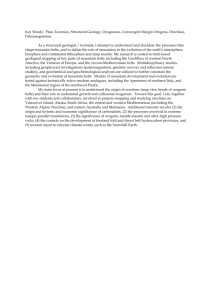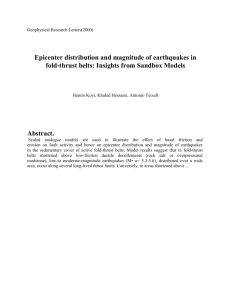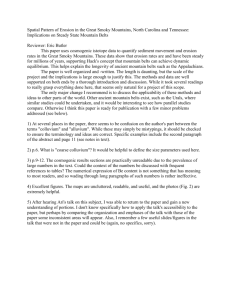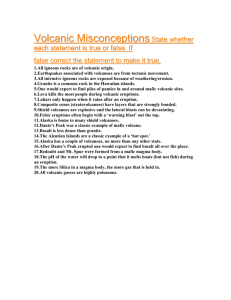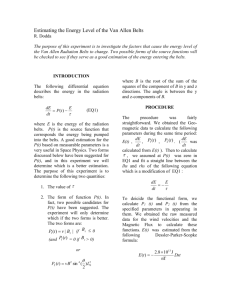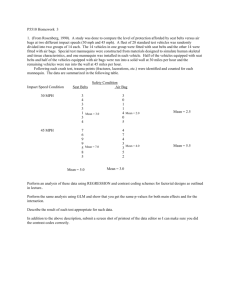WEST AFRICAN CRATON West Africa, an area roughly the size of
advertisement
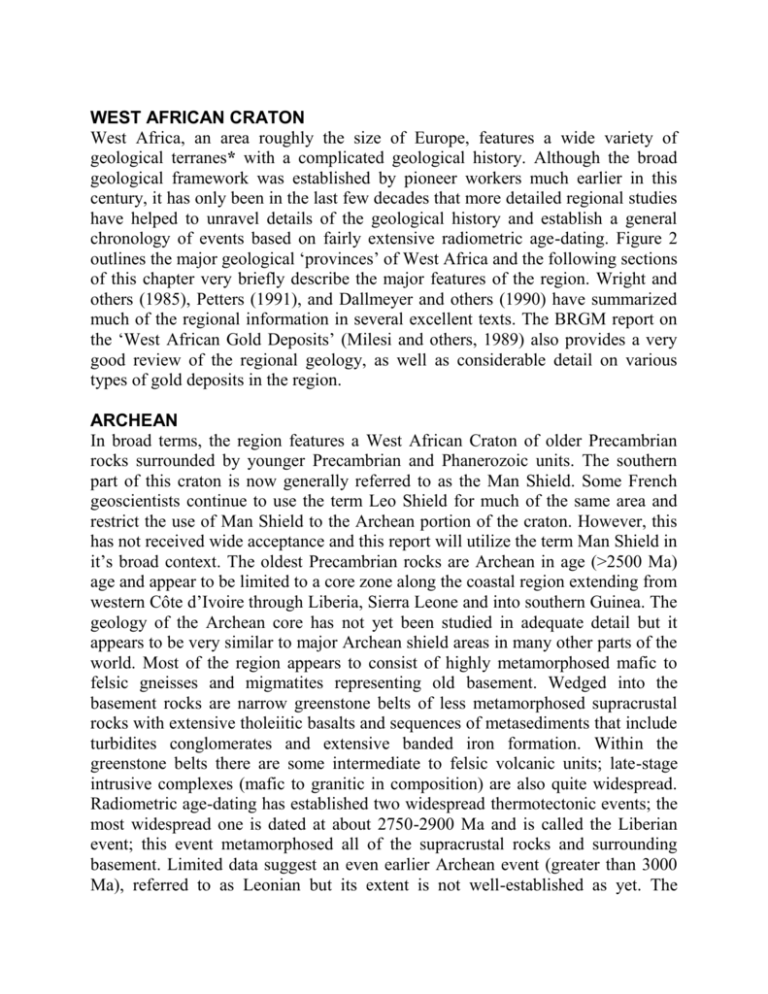
WEST AFRICAN CRATON West Africa, an area roughly the size of Europe, features a wide variety of geological terranes* with a complicated geological history. Although the broad geological framework was established by pioneer workers much earlier in this century, it has only been in the last few decades that more detailed regional studies have helped to unravel details of the geological history and establish a general chronology of events based on fairly extensive radiometric age-dating. Figure 2 outlines the major geological ‘provinces’ of West Africa and the following sections of this chapter very briefly describe the major features of the region. Wright and others (1985), Petters (1991), and Dallmeyer and others (1990) have summarized much of the regional information in several excellent texts. The BRGM report on the ‘West African Gold Deposits’ (Milesi and others, 1989) also provides a very good review of the regional geology, as well as considerable detail on various types of gold deposits in the region. ARCHEAN In broad terms, the region features a West African Craton of older Precambrian rocks surrounded by younger Precambrian and Phanerozoic units. The southern part of this craton is now generally referred to as the Man Shield. Some French geoscientists continue to use the term Leo Shield for much of the same area and restrict the use of Man Shield to the Archean portion of the craton. However, this has not received wide acceptance and this report will utilize the term Man Shield in it’s broad context. The oldest Precambrian rocks are Archean in age (>2500 Ma) age and appear to be limited to a core zone along the coastal region extending from western Côte d’Ivoire through Liberia, Sierra Leone and into southern Guinea. The geology of the Archean core has not yet been studied in adequate detail but it appears to be very similar to major Archean shield areas in many other parts of the world. Most of the region appears to consist of highly metamorphosed mafic to felsic gneisses and migmatites representing old basement. Wedged into the basement rocks are narrow greenstone belts of less metamorphosed supracrustal rocks with extensive tholeiitic basalts and sequences of metasediments that include turbidites conglomerates and extensive banded iron formation. Within the greenstone belts there are some intermediate to felsic volcanic units; late-stage intrusive complexes (mafic to granitic in composition) are also quite widespread. Radiometric age-dating has established two widespread thermotectonic events; the most widespread one is dated at about 2750-2900 Ma and is called the Liberian event; this event metamorphosed all of the supracrustal rocks and surrounding basement. Limited data suggest an even earlier Archean event (greater than 3000 Ma), referred to as Leonian but its extent is not well-established as yet. The Archean units are mainly bounded on the east in Côte d’Ivoire by the very prominent Sassandra fault, a large N-S regional feature, which generally separates the Archean units from younger Paleoproterozoic metasediments and metavolcanic units still further to the east. The northern boundary is also marked by extensive, shallow dipping faults marking a zone where the same Paleoproterozoic units of Guinea and northern Côte d’Ivoire have been thrust southwards onto the older cratonic block. The banded iron formations of the Archean greenstone belts have been developed on a substantial scale in Liberia and both Sierra Leone and Guinea have large resources with excellent potential for future development. These belts contain numerous gold occurrences and some indications of base metals, which warrant further attention. The Archean cratonic area also hosts quite widespread diamond-bearing kimberlites of Mesozoic age. Alluvial diamonds from these intrusions have been mined quite extensively in Guinea and Sierra Leone. PALEOPROTEROZOIC The most extensive units of the Man Shield are the Paleoproterozoic metasediments, metavolcanics and associated intrusive complexes that are exposed in a more or less continuous X-shaped pattern that covers much of Ghana, Côte d’Ivoire, Burkina Faso and into southern Mali, northern Guinea and the SW corner of Niger. Inliers in western Mali and eastern Senegal confirm that Paleoproterozoic units probably underlie large areas in northern Burkina Faso and Mali where they are covered by unmetamorphosed Infracambrian-Paleozoic sediments. Virtually all of the Volta Basin in northern and eastern Ghana will also be underlain by Paleoproterozoic units and there are also equivalent rocks in NW Africa, which suggest that much of the western Sahara has the same but buried Paleoproterozoic cratonic units. *In this report we use the term ‘terrane’ in the geological sense (for example, Archean or Birimian terrane) whereas the term ‘terrain’is used in the geographical or topographical sense (for example, hilly terrain or the terrain of northern Ghana).*The term ‘Birrimian System’ was first coined by Sir Albert Kitson in 1918 for a type locality of metasediments and metavolcanics inthe Atewa Range of the Kibi District of Ghana, which is the headwater area for the Birim River. The term ‘Birrimian’ later becamewidely used by anglophone and francophone geologists throughout West Africa. Unfortunately, the name of the river was later changedto Birim and subsequently an effort was made by geologists in Ghana to make the minor modification ‘Birimian’ and this is now widely accepted although many francophone geologists have continued the older usage ‘Birrimian’. Both terms should be considered correct although it is more appropriate to use the term ‘Birimian’ to reflect the now accepted spelling of the Birim River where the term wasfirst applied. From an economic viewpoint, the Paleoproterozoic metasediments, volcanics and related intrusives are extremely important as they host the vast majority of the substantial gold resources of the region and, in addition, they host important manganese deposits. The base metal potential appears less certain although one significant volcanogenic massive sulphide (Zn) deposit has been outlined in Burkina Faso (Perkoa) and base metalanomalies in a number of belts in the region warrant more systematic evaluation. BIRIMIAN SUPERGROUP The most important Paleoproterozoic units are extensive sediments and volcanics, which are generally referred to as the Birimian Supergroup*. The Birimian rocks are very widely distributed throughout a large part of West Africa. Over the decades, there has been some controversy on the relative ages and stratigraphic positioning of the Birimian units. This has partly resulted from efforts to extend observations from isolated areas to regional generalizations. The problems of correlation have also been much compounded by generally poor exposures in most areas. For example, in Ghana for most of the 20th century, the traditional view has been that the dominantly metasedimentary sequences. (Lower Birimian) are overlain by the more volcanic-rich sequences (Upper Birimian). Many of the geologists in the francophone countries observed relationships, which suggested the opposite. Within the past couple of decades, numerous excellent regional studies on the structural and stratigraphic relationships in the Birimian have been carried out by the German Geological Survey group (BGR) in cooperation with the Ghana Geological Survey (GGS) and more recently in Côte d’Ivoire. Their studies (Hirdes and others, 1993; Zitzmann, 1997) have concluded that the dominantly sedimentary sequences, which occur in large basins, are largely coeval with the metavolcanics,volcaniclastics, and metasediments, which occur in relatively narrow NE trending belts. The marine sediments in the basins were largely derived from volcanic terrane in the nearby belts. Results of field mapping and age-dating in northern Côte d’Ivoire have revealed some interesting variations, which may have regional implications. Hirdes and others (1996) present quite strong evidence from fairly precise U-Pb age-dating that indicates there may be two distinct ages for the Birimian volcanic belts and sedimentary basins in West Africa. The eastern belts appear to be consistently older (2150-2185 Ma) by about 50 million years than belts and basins further to the west(approximately 2105 Ma). It has been suggested that the term ‘Birimian’ be used to refer to the supracrustal rocks (belts and basins) from the older eastern region, whereas the term ‘Bandamian’ be used to refer to similar but younger supracrustal units in the western regions. It is probably a little premature to modify the nomenclature beyond the immediate confines of the relevant belts and basin in NE Côte d’Ivoire until such time as there is more corroborative data from the numerous belts and basins further to the west. Certainly this work does confirm that we are likely to see many modifications to the current broad models as more detailed field studies and improved age-dating techniques are applied to the vast expanse of Paleoproterozoic units in West Africa. For purposes of this report, we will continue to use the term ‘Birimian’ for all of the Paleoproterozoic supracrustal units of the belts and basins in West Africa.As noted above, the Birimian throughout the region consists of narrow ‘greenstone’ (volcanic) belts, which can be traced for hundreds of kilometres along strike but are usually only 20-60km wide and they are separated by wider basins of mainly marine clastic sediments. Along the margins of the basins and belts there appears to be considerable interbedding of basin sediments and volcaniclastic and pyroclastic units of the volcanic belts. Thin but laterally extensive chemical sediments (exhalites), consisting of cherts, fine-grained manganeserich and graphitic sediments, often mark the transitional zones. The margins of the belts commonly exhibit faulting on local and regional scales and these structures are fundamentally important in the development of gold deposits for which the region is now well-known.However, many of the belts also feature extensive regional faults cutting across entire belts and the structural evolution of many of the fault systems is varied and extremely complicated. Within the volcanic belts, the actual amount of volcanic flows is quite variable. Most of the older volcanics are mafic in composition and usually display geochemical characteristics typical of tholeiitic (oceanic) suites. Many of the flows are massive although pillow structures are preserved in some localities. Younger intermediate to felsic volcanics of calc-alkaline affinity, including pyroclastics, are generally subordinate; this appears to be the case in the volcanic belts of Ghana, although they are a little more widespread in some of the belts further to the west and in Burkina Faso. The volcanic belts also include substantial coarse volcaniclastic units, which appear to grade laterally into finer grained, more distal units towards the basins where they are commonlyinterbedded with basin clastics (wackes and argillites). Faulting and folding within the belts are very widespread and it is not possible to accurately determine the total thickness of the volcanics and related units but they most likely exceed 10,000m. Of course, current models indicate volcanism was accompanied by extensive erosion into the adjacent basins so that most of the volcanic chains, which were active for a long period of time, were substantially denuded so that we are now left with vestiges of the original volcanic units. The highly folded, thick sedimentary suites of the basins feature a variety of facies; argillites and wackes are the most common lithologies and it is common to see these in thin bedded units with features common to classical flysch sequences. The extensive isoclinal folding and generally poor exposures make it difficult to estimate the total thickness of the basin sediments but certainly they would also appear to be very thick, also probably at least 10,000m.All of the Birimian sediments and volcanics have been extensively metamorphosed; the most widespread metamorphic facies appears to be greenschist, although in many areas, higher temperatures and pressures are indicated by amphibolite facies. Detailed studies (John and others, 1998) in the southern part of the Ashanti belt indicate that the current greenschist facies seen in much of the area is probably a retrograde effect and the peak metamorphism took place under amphibolite facies conditions. This pattern may well extend to other belts in the region. On a regional basis, it would generally appear that as you go north from the coastal areas into northern Ghana, Côte d’Ivoire and Burkina Faso, the general levels of metamorphism increase. This probably reflects the deeper levels of erosion in the north in comparison to the southern exposures of the belts and basins. Detailed structural studies in the region are fairly limited.Studies in the western part of the region (Milesi and others, 1992) have proposed several separate phases of folding and fracturing. However, a regional synthesis by Eisenlohr (1989) has concluded that, although there is onsiderable heterogeneity in the extent and styles of deformation in many areas, most of the structural elements have common features, which are compatible with a single, extended and progressive phase of regional deformation involving substantial NW-SE compression. According to Feybesse and others (1994), as well as Ledru and others (1994), this extended period of compression resulted in early stage N-S sinistral (leftlateral) faults of regional extent and later stage dextral (right lateral) faults oriented approximately NE-SW. A considerable amount of thrusting with a SE vergence was localized along the margins of the major volcanic belts.This is well displayed on the NW margin of the Ashanti Belt in Ghana. The metamorphism, deformation and extensive intrusive activity (see a subsequent sub-section of this chapter) are all part of the Eburnean thermotectonic event (or orogenic cycle), which produced mountain belts. The Eburnean (or Eburnian) orogenic event* (Hirdes and others, 1996) appears to have generally peaked at about 2100Ma and appears to have affected virtually all of the Paleoproterozoic units in West Africa. The waning phase of this orogenic cycle included the widespread development of granitoid intrusions within the highly deformed, sedimentary basins. These intrusions have been generally dated at around 2090 Ma and they are generally associated with waning phases of the Eburnean orogenic cycle. TARKWAIAN GROUP AND EQUIVALENTS The Tarkwaian** Group consists of a distinctive sequence of metasediments occurring within a broad band along the interior of the Ashanti Belt. They host important paleoplacer gold deposits in the Tarkwa district. Equivalent rock types occur in quite a few other belts of the region but in relatively restricted areas. As yet, none of the other bands of Tarkwaian equivalents are known to host major gold deposits although the potential of the Bui Belt in west-central Ghana is considered encouraging. *The term ‘thermotectonic event’ has been widely used to refer to major metamorphic/tectonic events where it is uncertain if a full orogenic cycle was completed. It has been mainly used to refer to Pan-African events (approximately 600-450 Ma) in various parts of Africa where the tectonic history was not well understood. In this report, the term thermotectonic event is used interchangeably with orogenic event **Early and more recent work in Ghana, has always separated the Tarkwaian Group from the Birimian units. The latter were sometimes referred to as the Birimian Series but now generally referred to as the Birimian Supergroup. As noted by Petters (1991), theTarkwaian Group was originally included in the definition of the Birimian Supergroup. In this report, we will continue to separate the two but in view of their close inter-relationship, a strong case could be made for including the Tarkwaian units as a group within the Birimian Supergroup, at least within the Ashanti Belt. Formal guidelines used in establishing stratigraphic nomenclature would probably restrict the usage of Tarkwaian Group to the Ashanti Belt since it is very unlikely that equivalent types of units in other belts were ever directly connected and probably formed at quite different periods of time. Elsewhere they should be referred to as fluvio-deltaic sedimentsor Tarkwaian equivalents. The Tarkwaian Group consists of a variety of sandstones (quartzites), conglomerates and argillites (phyllites). In the type locality at Tarkwa, the sequence is in the order of 2500m thick, whereas in the Bui belt further to the north, comparable units are about 9000m thick (see next chapter for more details). The most extensive and widely reported sedimentological study was in the Tarkwa district by Sestini (1973) who concluded that the Tarkwaian units were largely deposited in shallow, non-marine, basins along the flanks of a volcanic chain. Much of the sediment was transported by fast flowing streams, which discharged their coarse load onto alluvial fans and in deltas along the margins of the basin and the fan deposits were progressively re-worked by braided river channels. This general pattern also fits the model established more recently in the Bui syncline by Keissling (1997) who recognized several major cycles of sedimentation in two separate basins, which eventually became linked. In classical terminology, the Tarkwaian units would be referred to as molasse sediments that mark a rapid period of erosion and proximal deposition during the late-stage of an orogenic cycle. There has always been much controversy on the relationships between the Tarkwaian and the underlying Birimian units. Many of the early workers in the region believed the contact to be an angular unconformity. The degree of metamorphism of the Tarkwaian was believed to be considerably less, and the styles and timing of folding and faulting between the two groups quite distinct. However, clear evidence to support these ideaswas generally lacking, partly because the contacts are rarely visible and usually are faulted. More recent work (Kiessling, 1997; Eisenlohr and Hirdes, 1992), which may well apply to most of the region, confirms that the Tarkwaian/Birimian contacts are almost invariably sheared. However, they appear to be generally unconformable where the underlying Birimian units are mainly volcanic, whereas they are essentially conformable where the underlying units are Birimian sediments. This work also recognizes that, although the structural styles may differ considerably, they resulted from the same tectonic regime and that both the Tarkwaian and Birimian units were affected by the same Eburnean metamorphic event. The metamorphic assemblages observed in some of the Tarkwaian units of the region indicate moderate temperatures and fairly high pressures equivalent to burial depths of 10 or more kilometres (Ledru and others, 1994). These conditions were probably achieved as a result of collisional tectonics in the Eburnean orogeny whereby Birimian units were thrust over and buried the Tarkwaian sediments to substantial depths. They were formed in small, fault-controlled (graben) basins developed in an extensional tectonic setting (Strogen, 1991). In the Ashanti Belt, the extensional nature of the tectonic setting is demonstrated by the presence of large numbers of mafic sills, which intruded the Tarkwaian basin prior to folding and metamorphism (Griffis, 1998). INTRUSIVES Throughout the Birimian sedimentary basins and volcanic belts, there are a large variety of intrusions and two dominant types of occurrences have been recognized in many parts of the region. Early workers in Ghana distinguished these as ‘Cape Coast’ and ‘Dixcove’ types. The more massive, ‘Cape Coast’ type batholiths are dominantly intermediate intrusives (generally K-rich) with biotite being the most common mafic mineral; typically they display foliation (often gneissic) and are concentrated in areas where Birimian metasediments are widespread. They are usually described as concordant and commonly have migmatitic phases on the margins and display prominent contact metamorphic aureoles. The ‘Dixcove’ type occurs mainly within the confines of the volcanic belts; they are also generally of an intermediate composition although more mafic and felsic phases are not uncommon. They tend to be more Na-rich and in the literature are often referred to as plagiogranites. Hornblende is usually the dominant mafic mineral and, in many cases, the intrusives lack strong foliation. They occur in quite small plutons to very large batholiths, although not as extensive as the major ‘Cape Coast’ complexes. They are frequently described as discordant intrusives. The relative ages are rarely established as the two types are not generally seen together but most workers in the past considered the ‘Cape Coast’ intrusives to be syn-tectonic bodies,whereas the ‘Dixcove’ units were considered to be latetectonic to post-tectonic intrusions. Elsewhere in the region, similar types have been recognized and sometimes given type designations from specific localities. In the recent regional mapping program (BGR/GGS) in SW Ghana, new terminology was proposed for the same broad types of intrusions. This included ‘basin’ granitoid for the Cape Coast type, which are confined to the sedimentary basins, and ‘belt’ granitoid for the ‘Dixcove’ type, which are largely confined to well-defined volcanic belts. This terminology will be generally followed in this report although, as will be noted in the following chapter, the designation as belt-or basin-type is not always straightforward. Considerable radiometric dating is now available for the granitoids in southern Ghana and contrary to previous assumptions, the belt-type (Dixcove) granitoids consistently yield dates very close to their Birimian hostrocks, whereas the basintype (Cape Coast) granitoids yield younger ages. The following sub-section provides a general chronology of geological events based on age-dating and includes a range of dates for the granitoids. As noted above, the ‘basin’ and ‘belt’ intrusives are generally of intermediate composition (granodiorite, tonalite, quartz diorite). The belt intrusives also include more mafic (diorite) phases and some complexes have more felsic phases (close to the true granites) but these are not usually very extensive. The basin granitoids also show considerable variation in composition but with relatively minor mafic phases, quite often with more prominent felsic phases, which are true granites and often accompanied by late-stage aplites and pegmatites. The basin granitoids generally feature lithological and geochemical characteristics (peraluminous) and a tectonic setting more or less comparable to S-type intrusives, which are believed to have formed by partial or complete melting in the roots of thick piles of sediments. In contrast, the belt intrusives have features more associated with I-type intrusives (metaluminous), which are believed to have had a more direct magmatic origin. However, in view of the fact that the basin sediments were derived from the volcanic belts, it is not surprising that there is a similarity in both types of intrusions. Although the vast majority of Paleoproterozoic plutons throughout the region fall within these broad categories, there are a few other distinctive types of intermediate to felsic granitoid, which occur locally in some of the basins and belts. For example, in northern Ghana, the Bongo-type granitoid (more or less restricted to the Nangodi belt segment) is a distinctive microcline-rich and hornblende-bearing granitoid, which is a very latestage intrusive associated with a waning phase of the Eburnean orogeny. In southern Ghana, the Winneba area also features exposures of granitoids somewhat similar to the more widespread basin-type (Cape Coast) intrusive batholiths but with geochemical features indicative of contributions from older sialic crust. These two types of intrusives will be discussed in more detail in the following chapter. Although there does not appear to be as much information in the geological literature on similar occurrences in other parts of West Africa, it can probably be assumed that the two principal types occur in other belts and basins further to the west and north. Not to be forgotten are a variety of mafic (mainly gabbro and diorite) intrusives, which are quite widespread within the volcanic belts, especially the Ashanti Belt, but largely absent from the adjacent basins. These intrusives are quite variable; many appear in close association with volcanicrich (mafic tholeiites) areas within the belts and are probably coeval with much of the volcanic activity. Some quite large mafic complexes occur sporadically, especially within the Ashanti Belt; these include, for example, the Mpohor diorite immediately NW of Takoradi. These are similar to descriptions of epidiorites in the early geological literature of the Ashanti Belt and they probably correlate with the very extensive mafic sills recently identified by airborne geophysics in the Tarkwaian units of the Ashanti Belt (Griffis, 1998). Similar types of intrusive have been identified in other volcanic belts of the region but they do not appear to be as widespread as in the Ashanti Belt. RADIOMETRIC AGE-DATING In the past two decades, many of the fundamental issues relating to the chronology of geological events in West Africa have been greatly illuminated by fairly extensive radiometric age-dating. Much of this work has been done by the team of BRGM scientists of France operating in the francophone countries and the BGR group of Germany who have carried out extensive regional work in Ghana and Côte d’Ivoire. It is beyond the scope of this report to review this work in detail but some general comments are warranted. Ages for the Birimian metasediments and metavolcanics in Ghana generally fall within the range of 2150-2200 Ma (Davis and others, 1994). Ages from detrital grains of zircons (Ashanti and Bui belt) generally fall within the same range and current evidence (Zitzmann and others, 1997) indicates that the Tarkwaian and Birimian units were derived from similar source areas although depositional activity in Tarkwaian basins may have been extended to about 2130 Ma. As noted previously, recent work in northern Côte d’Ivoire (Hirdes and others, 1996) has demonstrated that volcanic belts and basins in the eastern area (Ghana, eastern Côte d’Ivoire) may be about 50 Ma older than similar areas further to the west. The age of peak metamorphism and the maximum stage of deformation, associated with the regional Eburnean orogeny, appear to closely approximate 2090-2100 Ma (Loh and Hirdes, 1996). This general age may well apply to the older, eastern belts and basins as well as the younger units further to the west. Extensive radiometric age-dating of intrusive activity in the region appears to fall into two distinctive ranges. As noted previously, and contrary to early views, the smaller discordant belt intrusives generally have ages that fall mainly in the same range 2150-2200 Ma as the Birimian metasediments and volcanics (Hirdes and others 1992; Loh and Hirdes 1996). The large basin intrusives are consistently younger than their belt counterparts and most radiometric age-dates fall in the range 2080-2125 Ma and appear to correlate well with the period of peak metamorphism. There is considerably less data on the relatively minor, late stage post-tectonic, K-rich intrusives such as the Bongo-type of northern Ghana but the latter has been age-dated at 1968 +/- 49 Ma. Quite imprecise ages for the Winneba granite, which is most similar in petrological characteristics to the basin granitoids, have been interpreted to reflect inherited features from older basement crust (Taylor and others, 1992). Dates are not available for the relatively late-stage mafic intrusive sills, dikes and possibly related mafic complexes (i.e., Mpohor) of the Ashanti Belt. Certainly the sills in the Tarkwaian sequences appear to pre-date the peak Eburnean metamorphism and they are likely to fall in the 2100-2150 Ma period. It should be emphasized that although the above general outline of the chronology of geological events probably applies to much of the Birimian/Tarkwaian terrane, there may be important local variations. More age-dating and isotopic studies throughout the region will further clarify regional and local geological events. TECTONIC MODELS For decades it was generally assumed that much of the Birimian terrane of West Africa is underlain by older (Archean) continental crust and most models on the tectonic development of the Birimian / Tarkwaian / Eburnean units adopted this concept. The basis for this was largely due to assumptions concerning the highgrade Dahomeyan metamorphic units present in southeastern Ghana and the widespread migmatites in northern Ghana, Burkina Faso and Côte d’Ivoire. These were believed to be equivalent to the Archean cratonic areas exposed in large parts of western Côte d’Ivoire, Liberia and Sierra Leone. However, quite extensive age- dating has yet to reveal any consistent indications of old crustal material. In fact, most of the areas believed to be Archean (i.e., the extensive migmatites of northern Ghana and neighbouring areas) have age-dates and geochemical characteristics that are similar to Eburnean basin granitoid complexes. The Dahomeyan metamorphic units yield much younger age-dates, which correspond to Pan-African (550-600 Ma) events. These dates may represent a re-setting of the radiometric clocks but few other geochemical features clearly point to older (Archean) crustal material. However, as noted earlier in this chapter, the geochemical characteristics of the Winneba granitoids suggest some possible inheritance from Archean crustal sources. The geochemical and isotopic data collected in many Birimian areas of West Africa indicate that much of the early tholeiitic volcanism and coeval intrusive activity (belt granitoids) have features of a juvenile magmatic origin. There is very little evidence that any of these areas were affected by any underlying older crust, which probably would have influenced ascending magma. For now, the issue is not fully resolved but the preponderance of current data does not support the presence of any substantial amount of Archean crust in the region now dominated by Birimian-age sediments, volcanics and related intrusions. However, the presence of highly attenuated, old sialic crust cannot yet be totally excluded; the attenuated zone may not have been thick enough to have significantly effected the geochemistry of Birimian magmas from an underlying mantle zone. The growing set of data on major, minor, and trace element geochemistry has resulted in new tectonic / structural models to explain the Birimian / Eburnean geological province. Earlier ideas on an initial stage of intracontinental rifting have been largely abandoned in favour of the development of a series of tholeiitic volcanic chains within an oceanic crustal environment (Boher and others, 1992). The tholeiitic volcanics were followed by calc-alkaline volcanism probably related to subduction beneath island arcs within an intraoceanic environment. New ocean was created and probably consumed along numerous parallel volcanic chains across a large area. The oceanic basins were closed by converging Archean cratonic blocks, which resulted in the accretion of Paleoproterozoic volcanic chains onto the margins of the older continental crustal blocks and by thick sequences of basin sediments extensively deformed and pushed onto, and in places, over the margins of volcanic belts. The deformational/tectonic regime was very complex with extensive movements on many major fault systems of regional extent. The peak period of deformation, metamorphism and development of widespread anatectic granite intrusive at the base of very thick, deformed sedimentary piles climaxed at about 2090-2100 Ma when a very large area of new continental Paleoproterozoic crust was created between older crustal blocks to the east and west. The region must have comprised a vast series of mountain ranges formed by thrusting of thick sequences of Birimian metasediments over many of the volcanic belts and Tarkwaian basins, which were deeply buried but later exhumed by extensive erosion. Although a great amount of new information has been synthesized into a general regional model, there remains much detail to be clarified. It is hoped that the laudable efforts over the past two decades on detailed field mapping, structural studies, radiometric age-dating and geochemical studies will be sustained.

